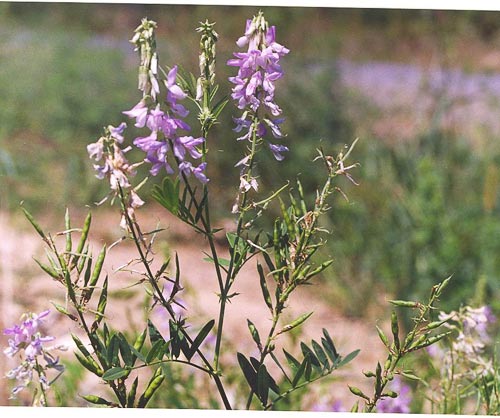Relatives
Galega officinalis L. - Goat.s rue, medicinal galega.
Taxonomic position.
Family Leguminosae Endl., genus Galega L.Biology and morphology.
Perennial with stems erect, branched, 80-150 cm tall and very leafy. Tap-rooted without root shoots. Leaves imparipinnate 15 cm long with 5-10 pairs of elongated leaflets, 1-4 cm long. Inflorescence is apical multi-flowered raceme up to 25 cm long. Flowers light blue or whitish. Pods glabrous, straight, turned upwards. Cross-pollinated. Blossoms in June and seeds ripen in August-September. 2n=16.Distribution.
West Europe, South Europe (Mediterranean Seashore), Asia Minor, South-West Asia (Iran).Ecology.
Mesophyte. Prefers riversides and wet meadows. Tolerates saline soils. In highlands it grows as high as 1600 m above sea-level.Utilization and economic value.
Valuable medicinal herb. Has potential as a natural fertilizer on saline soils. Fodder use is restricted due to high content of galegin alkaloid in herbage which can cause intoxication of animals. Improves soil structure and fertility.Reference citations:
Galushko, A.I. 1980. Flora of Northern Caucasus. Rostov-na-Donu. V. 2: 350. (In Russian)Grossheim, A.A. 1952. Genus Galega. Flora of the Caucasus. Moscow-Leningrad: AN USSR. V. 5: 234-235. (In Russian)
Komarov, V.L., ed. 1945. Flora of the USSR. Genus Galega. Moscow-Leningrad: AN USSR. V. 11: 303-304. (In Russian)
Kolakovskiy, A.L. 1958. Flora of Abhasiya. Tbilisi. V. 3: 292. (In Russian)
Medvedev P.F., Smetannikova A.I. 1981. Forage plants of the European part of the USSR. Leningrad: Colos. 335 pp. (In Russian)
Phedorov, A.A., ed. 1987. Flora of the European part of the USSR. V. 6: 254. (In Russian)
Uteush U.A. 1991. New perspective fodder crops. Kiev: Naukova dumka. 192 pp. (In Russian)


